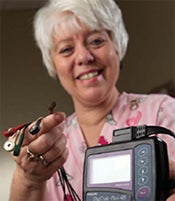Holter and Event Monitoring
Holter Monitor
If you are having an irregular or rapid heartbeat, dizziness or palpitations, a test that may help your doctor determine when these episodes occur is a Holter Monitor, which is essentially a portable electrocardiogram (EKG or ECG.)
During the Test
Patients are hooked up using electrodes to the portable unit, wearing it for 24 or 48 hours. During that time, you will continue with your normal activities, including work, exercise, sleep or whatever you may typically do during a 24-hour period.
The technologist will place electrodes at different areas around your chest, securing them with sticky patches. Wires run from the patches to the portable box, which looks similar to a small tape player. You can either attach it to your belt or carry it with a shoulder strap.
Throughout the day, you will record any time you experience symptoms – like a change in your heart rate, fluttering, dizziness or even fainting. You will log what you were doing at the time so your doctor will know what may trigger these events.
After the Test
Once the 24 hour-period is completed; you will return the unit to us. We will download the information that documents the episodes and look for abnormalities in your heart rhythm. Once your doctor analyzes the results of the Holter Monitor report, he or she will talk with you about next steps in your care.
Event Monitor
If you are having irregular arrhythmia (abnormal heartbeat), a test that may help your doctor determine when these episodes occur is an Event Monitor, which is essentially a portable electrocardiogram (EKG or ECG) that measures specific cardiac “events.”
During the Test
Patients are hooked up using electrodes to the portable unit, wearing it for a designated time recommended by your doctor (usually 30 days). During that time, you will continue with your normal activities, including work, exercise, sleep or whatever you may typically do during the week.

The technologist will place electrodes at different areas around your chest, securing them with sticky patches. Wires run from the patches to the portable box, which looks similar to a small tape player. You can either attach it to your belt or carry it with a shoulder strap.
The technologist will teach you how to remove the device so you can bathe or shower. When you feel symptoms, press a button to start recording the episode, which is saved for interpretation. The episode is immediately sent to us so your doctor can review it. If the reading is indicative of an emergency, you will be referred to the closest emergency department.
Once your doctor analyzes all of the results of the Event Monitor report, he or she will talk with you about next steps in your care.
How to Prepare for a Holter Monitor Test
The following explains how the Holter Monitor Test works as well as what you need to do in order to prepare for the test.
You will have an appointment for your monitor fitting.
- A technician will place electrodes that sense your heartbeat on your chest.
- Using wires, the technician will then connect the electrodes to the recording device, which you can wear on your waistband or belt.
- The fitting takes about 20 minutes.
You will be asked to keep a journal.
- You will also be asked to keep a journal of your activities and symptoms and when they occur while you wear the monitor.
- Be particularly mindful of such symptoms as skipped heartbeats, shortness of breath or chest pain.
You will be allowed to continue with daily activities.
- Aside from bathing, you can go about your regular daily activities while you are wearing the Holter monitor.
- You are welcome to wash your hair and sponge bathe keeping the water away from the electrodes and wires.
- Holter monitors are quite reliable, easy to use and subject to very little interference from external energy sources such as power lines, magnets and metal detectors.
- In order to increase the diagnostic yield of Holter monitoring, it is critical that patients do not vary from their daily routines while wearing the device.
*For some patients who may have less frequent symptoms, an implantable loop monitor may be a good alternative to the Holter monitoring system and has been shown in several studies to significantly improve our ability to make a diagnosis.
There is also a new short-term wireless monitoring system called a Ziopatch that we are currently evaluating in clinical trials. Your cardiologist can help decide which type of monitoring system is best for you.
Determining How Long Your Test Will Last
- How long you wear the monitor depends on the condition your doctor suspects you have.
- Once the monitor is removed, the doctor will compare your journal entries with the data from your monitor and diagnose your condition or determine if additional testing is needed.
